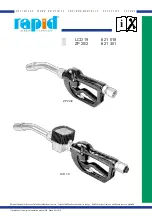
12 – English
MAINTENANCE
LUBRICATION
Frequent, but not excessive, lubrication is required for
best performance. Oil for pneumatic fastening tools added
through the air line connection will lubricate the internal
parts. Do not use detergent oil or additives as these oils
will cause accelerated wear to the seals and bumpers in
the tool, resulting in poor tool performance and frequent
tool maintenance.
COLD WEATHER OPERATION
For cold weather operation, near and below freezing, the
moisture in the air line may freeze and prevent tool operation.
We recommend the use of air tool oil or permanent antifreeze
(ethylene glycol) as a cold weather oil.
NOTICE:
Do not store tools in a cold weather environment
to prevent frost or ice formation on the tools’
operating valves and mechanisms that could cause
tool failure.
NOTE:
Some commercial air line drying liquids are harmful
to “O” rings and seals. Do not use these low temperature
air dryers without checking compatibility.
AIR SUPPLY PRESSURE AND VOLUME
Air volume is as important as air pressure. The air volume
supplied to the tool may be inadequate because of undersize
fittings and hoses, or from the effects of dirt and water in the
system. Restricted air flow will prevent the tool from receiving
an adequate volume of air, even though the pressure reading
is high. The results will be a slow operation or reduced
driving power. Before evaluating tool problems for these
symptoms, trace the air supply from the tool to the supply
source for restrictive connectors, low points containing
water and anything else that would prevent full volume flow
of air to the tool.
WARNING:
When servicing use only identical RIDGID
replacement parts. Use of any other parts may
create a hazard or cause product damage.
WARNING:
Always wear eye protection with side shields
marked to comply with ANSI Z87.1. Failure to do
so could result in objects being thrown into your
eyes resulting in possible serious injury.
WARNING:
Disconnect the tool from the air supply before
performing maintenance. Failure to do so could
result in serious personal injury.
GENERAL MAINTENANCE
Avoid using solvents when cleaning plastic parts. Most
plastics are susceptible to damage from various types of
commercial solvents and may be damaged by their use. Use
clean cloths to remove dirt, dust, oil, grease, etc.
WARNING:
Do not at any time let brake fluids, gasoline,
petroleum-based products, penetrating oils, etc.,
come in contact with plastic parts. Chemicals can
damage, weaken or destroy plastic which may
result in serious personal injury.
If a nail or fastener becomes jammed in the tool, disconnect
the air hose and keep the tool pointed away from you while
clearing the jam.
Disconnect the tool from the air supply.
Remove fasteners from the tool.
To gain access to the jammed nail or fastener, unlock the
jam-clearing mechanism by pushing the latch toward the
nose of the tool and allowing it to flip open.
Remove the bent nail, using needle-nose pliers if necessary.
After the nail or fastener has been removed, close the jam-
clearing mechanism and secure it in place.
NOTE:
The jam-clearing mechanism should always be
closed when operating this tool.
If the jam is severe or if the nail is difficult to remove:
Insert a #2 Phillips screwdriver into the driving mechanism.
Tap the screwdriver gently with a hammer. The inserted
screwdriver should push the driver blade back, freeing
the nail jam.
After the nail or fastener has been removed, close the jam-
clearing mechanism and secure it in place.
NOTE:
The jam-clearing mechanism should always be
closed when operating this tool.
OPERATION











































